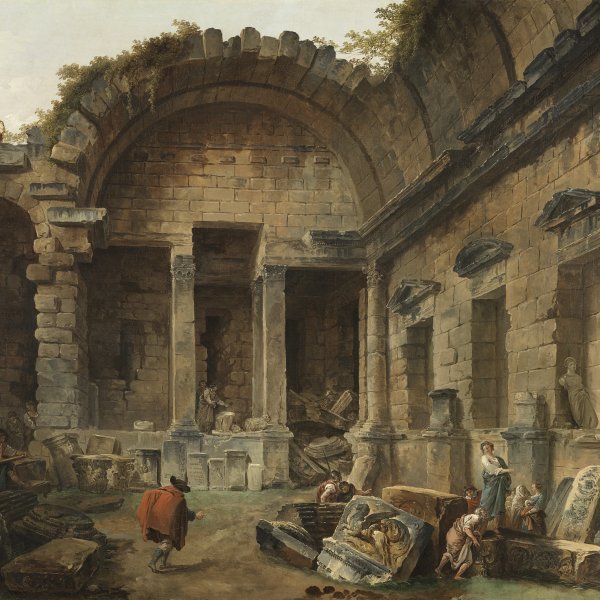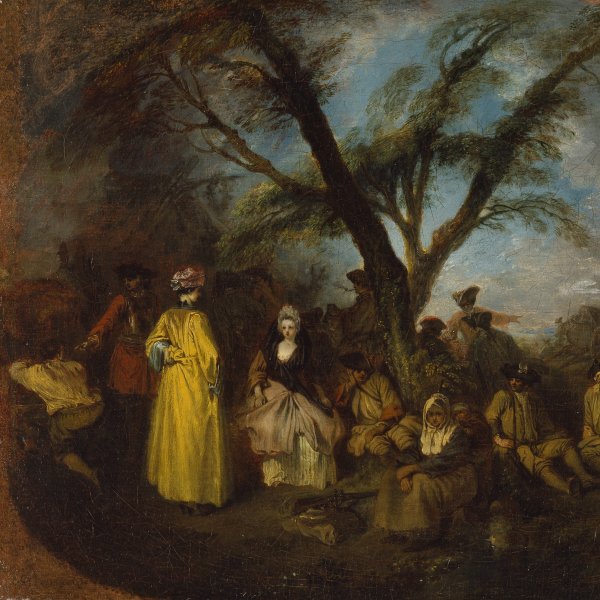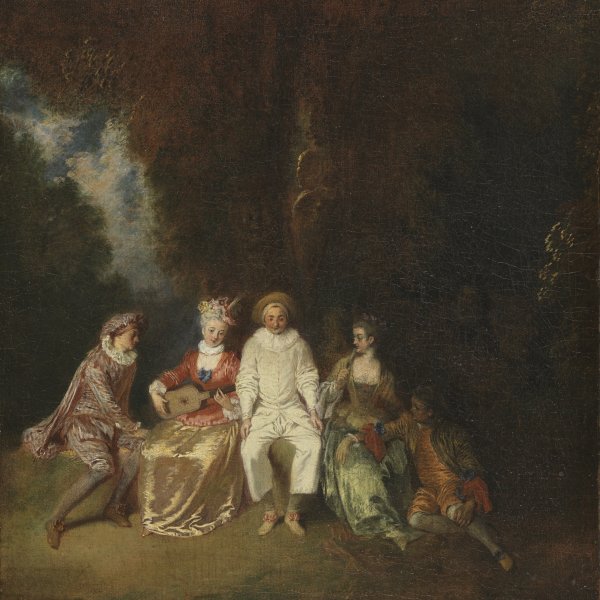The Earth
Oil on canvas.
38 x 31 cm
Museo Nacional Thyssen-Bornemisza, Madrid
Inv. no.
216
(1977.33
)
ROOM 24
Level 2
Permanent Collection
This canvas forms part of a series on the Four Elements, a theme that was popular during the 17th century and which frequently took the form of depictions of figures engaged in tasks appropriate to each element. The present series was commissioned from Lancret by the Marquis of Béringhen to decorate a room in his Paris hotel on the rue Saint-Nicaise. An inventory drawn up on the Marquis’ death notes that the series was hung in a room that looked onto the garden. The Marquis was a patron of the arts whose collection included compositions by Jean-Baptiste Oudry, François Boucher and Jean François de Troy. The series to which the present canvas belonged was reproduced in engravings by four artists: Nicolas Tardiu, who depicted Air; Louis Desplaces, Water, Charles-Nicolas Cochin, Earth; and Benoit Audran, Fire. The complete series of prints was put on sale by the Veuve Chéreau in August 1732, and was advertised in the Mercure de France which also supplied the additional information that the prints were based on original paintings by Lancret that were in the collection of Marquis of Béringhen and supplied the names of the four printmakers. The account in the Mercure, which describes the paintings in a general manner, has proved a valuable reference point for dating the series.
After the Marquis’ death, the set of the Four Elements was auctioned in 1770 and entered the collection of the Marquis of Lassay, who sold the group in 1775. In 1884 Earth and Water were to be found in Halton Manor, the English residence of Alfred de Rothschild. From there Earth passed into the collection of the Countess of Carnarvon who owned it until 1977, at which date it entered the present Collection.
Lancret constructs the framework of his scene through the presence of a large tree on the left and part of a monumental fountain on the right. His orchard-garden is the setting for country workers on the left and a group of ladies and gentleman on the right who amuse themselves passing a day collecting the fruits of the earth, with the exception of the young man who is busy courting one of the ladies and is depicted offering her a bouquet of flowers. The rest of the group — three women on the ground and another standing next to the ladder — are engaged in selecting fruit. Lancret uses a soft chromatic range with subtle, attractive juxtapositions such as the yellow and blue of the dress of the standing woman and the shot colours of the skirts and bodices of the woman in the foreground and the one about to receive the bouquet of flowers. This approach to colour is also evident in the three principal elements of the background, namely the sky, the dense foliage of the tree and the fountain. The figures’ gestures are equally delicate although they lack that sense of fragility and vulnerability to be found in Watteau’s characters.
Of the other three canvases that made up this set, only the whereabouts of Fire is known, now in the Galleria Nazionale d’Arte Antica in the Palazzo Barberini, Rome. The Rothschild collection at Waddesdon Manor (UK) has a drawing by Lancret for a figure of a standing woman holding up her skirts. A second drawing of the seated man with the bouquet of flowers is in the Musée Carnavalet in Paris.
Mar Borobia
After the Marquis’ death, the set of the Four Elements was auctioned in 1770 and entered the collection of the Marquis of Lassay, who sold the group in 1775. In 1884 Earth and Water were to be found in Halton Manor, the English residence of Alfred de Rothschild. From there Earth passed into the collection of the Countess of Carnarvon who owned it until 1977, at which date it entered the present Collection.
Lancret constructs the framework of his scene through the presence of a large tree on the left and part of a monumental fountain on the right. His orchard-garden is the setting for country workers on the left and a group of ladies and gentleman on the right who amuse themselves passing a day collecting the fruits of the earth, with the exception of the young man who is busy courting one of the ladies and is depicted offering her a bouquet of flowers. The rest of the group — three women on the ground and another standing next to the ladder — are engaged in selecting fruit. Lancret uses a soft chromatic range with subtle, attractive juxtapositions such as the yellow and blue of the dress of the standing woman and the shot colours of the skirts and bodices of the woman in the foreground and the one about to receive the bouquet of flowers. This approach to colour is also evident in the three principal elements of the background, namely the sky, the dense foliage of the tree and the fountain. The figures’ gestures are equally delicate although they lack that sense of fragility and vulnerability to be found in Watteau’s characters.
Of the other three canvases that made up this set, only the whereabouts of Fire is known, now in the Galleria Nazionale d’Arte Antica in the Palazzo Barberini, Rome. The Rothschild collection at Waddesdon Manor (UK) has a drawing by Lancret for a figure of a standing woman holding up her skirts. A second drawing of the seated man with the bouquet of flowers is in the Musée Carnavalet in Paris.
Mar Borobia









